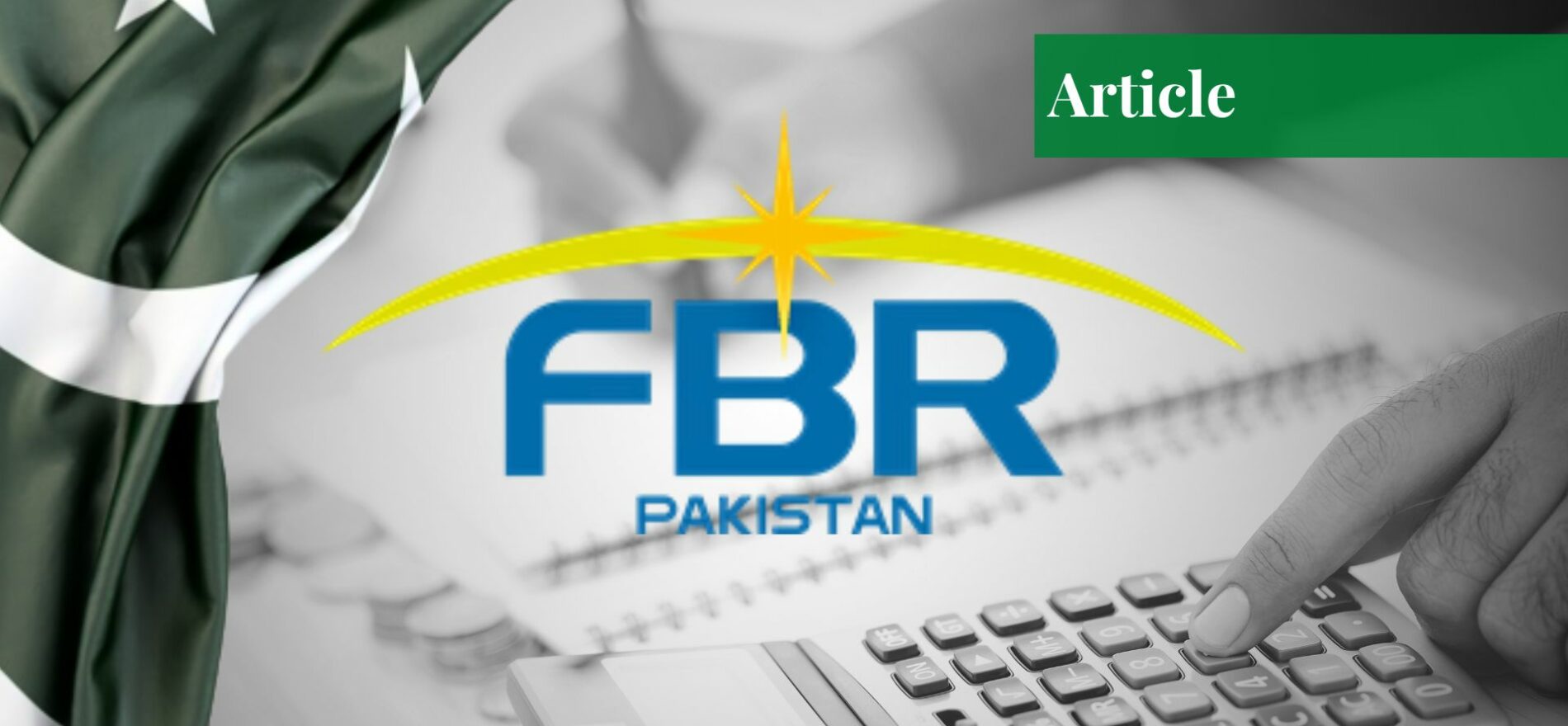Iman Faisal is currently pursuing her bachelor's in peace and conflict studies from National Defense University Islamabad. Her areas of interest are the Middle East, South Asia, Africa, sectarian conflicts, terrorism, and criminology.
FBR of Pakistan & the Role of Chairman
The Federal Board of Revenue (FBR) of Pakistan is a government-affiliated institution that is responsible for administering taxes and assignments related to customs under the government of Pakistan. It is the central revenue collection agency in Pakistan, with the FBR headquarters located in Islamabad. The chairman of FBR is the one who connects with all the ministries and departments of finance before reporting to the prime minister and the president.
Currently, the FBR is headed by Mr. Malik Amjed Zubair Tiwana. The chairman’s duties involve the formulation and administration of fiscal policies, the imposition and collection of federal taxes, and the quasi-judicial function of hearing appeals. In simple words, the chairman of FBR is responsible for imposing and collecting taxes, generating revenue for improving the economic health of the country, hearing and resolving disputes among individuals or organizations and the federal government, and regulating industries.
History of Federal Board of Revenue (FBR)
Established on 1st April 1924, the Federal Board of Revenue was initially named the Central Board of Revenue. It functioned as the revenue division under the Ministry of Finance from 1944. After Pakistan came into being, the same structure continued till the 1960s. On the suggestions of the Administrative Reorganization Committee, FBR was made an attached department of the Ministry of Finance.
In 1974, several reforms were made to make the operations, within the organization, run smoothly. To make the formulation and implementation of fiscal policies effective and streamline the administration of the institution, the status of FBR as the revenue division under the Ministry of Finance was restored. Afterwards, it was abolished, and then again restored. Finally, in July 2007, the FBR Act 2007 was passed and the Central Board of Revenue was named the Federal Board of Revenue.
FBR’s Commitment to Transparency & Accountability
The central aim of such an establishment is to collect fair taxes, employ modern and up-to-date methods, and encourage compliance with tax and related laws. It also tends to raise awareness among people to place their trust in government organizations and be contributing citizens of the country. FBR has developed a systematic departmental arrangement that facilitates taxpayers in filing tax returns, lodging queries or complaints, resolving disputes, and getting registered. The dedicated and responsive officials ensure transparency of all procedures.
Structure of FBR in Pakistan
Like every institution, FBR also has a structure that distributes responsibilities into wings/directorates. These wings are further divided into specialized departments which handle several tasks related to taxation. Each wing/directorate has its own chiefs, who are subordinated by secretaries, who are then further subordinated by second secretaries. Each wing and department has to work in collaboration with the other to achieve the set targets of tax collection, implementation of tax laws, and improvement of the efficiency of the institution, in general.
1. Inland Revenue
Income tax, sales tax, and federal excise duty are collectively called domestic taxes. They are administered by the department of Inland Revenue (IR), also referred to as the tax office. Hence, the wing of Inland Revenue was created to improve tax to GDP ratio by employing modern techniques for imposing and collecting taxes. The wing of Inland Revenue has three chiefs with different sections working under them.
Chief IR (HQs)
The Chief IR (HQs) has four subsections working under him. These include:
- Judicial Section
The judicial section deals with ADR (Alternate Dispute Resolution) matters, Federal Tax Ombudsman (FTO) matters, legal matters like appeals and court cases, Parliament business, Cabinet matters, and any other assigned job.
- Coordination Section
As per the name, this section carries out coordination among concerned departments on income tax (IT) and sales tax-related matters – which include taxpayers’ registration for income and sales tax – organizes conferences and does other assigned jobs.
- General Section
It caters the matters related to rewards for detecting tax evasion, reforms, restructuring, and reorganization. It also deals with matters pertaining to financial laws and institutions, particularly the Pakistan Revenue Automation Ltd. (PRAL) . Like others, it is also responsible for any other tasks assigned by the chairman of FBR.
- Revenue Budget
This department is accountable for the assignment and monitoring of income tax, sales tax, and FED collection. It is in charge of tax refunds along with the authorization of banks for the collection of revenue.
Inland Revenue (IR) Policy
There are two chiefs that look after the domains of sales tax (ST) and federal excise duty (FED) policy, and income tax policy (ITP), respectively. The secretary of the ST/FED budget works under the supervision of the chief of ST and FED policy. His assigned tasks include budget and policy matters related to taxable goods and services, clarification and valuation of goods and tariff values as well as procedure and interpretation of laws. The chief of income tax policy directs secretaries to handle their assignments. The secretaries and their profiles are as under:
- Secretary ITP looks into income tax policy and its clarification.
- Secretary Withholding Taxes (WH) deals with withholding taxes, a type of IT paid by the employer rather than the recipient. Withholding taxes allows governments to collect income tax at the source of income by placing the responsibility of tax collection on the employer.
- Secretary Exemptions/IT Rules cater duties related to income or sales tax exemptions, second schedules or income tax rules.
- Secretary International Taxes takes care of international taxes, income tax and sales tax, coordination/liaison with the IMF, World Bank, International Finance Corporation (IFC), and the Organisation for Economic Co-operation and Development (OECD). The secretary is also responsible for matters related to international tax agreements/treaties.
Generally, the significant duties of this branch are to collect taxes, formulate and implement tax policies, and assist the taxpayers in filing their tax returns without any difficulty, all under a single organizational unit. A single department makes data of taxpayers in all the domains of domestic taxes easily available and accessible. This streamlines the administration process.
2. Pakistan Customs
The Department of Customs is the first line of defense against the trade of illicit merchandise. It encourages transparent trade and tends to generate massive revenue for the financial health of the country. It collects tariffs on goods and services being traded across the border. The customs play a strong role in safeguarding domestic industries by employing a system that discourages the use of luxurious imported items.
3. Public Relations
Hierarchy of the Public Relations Office
Within the office of Public Relations (PR), member PR is at the top of the hierarchy and then comes the chief of PR. Two organs work under the chief. The first organ consists of the secretary (compliance), secretary (facilitation), secretary (media), and secretary (tax education). All the secretaries are followed by second secretaries. The other organ consists of a web team, email team, call center, and customer relationship management.
The Role of PR Department in the FBR
PR puts efforts into creating a better understanding among people and institutions. The PR department of FBR is also the same. It conducts seminars, workshops, and lectures in collaboration with different organizations like the Chamber of Commerce, universities, and colleges to create awareness about different types of taxes. It also designs media campaigns to reach out to the masses and updates legal resources and brochures with the latest information on the successes of the institution.
Various helplines are projected in campaign ads, brochures, and websites for people to contact in case of any queries or complaints. The questions or complaints are forwarded to the relevant department for further processing. The PR wing also helps in disposing of cases of delay in refund, selection of audit withdrawal, increasing the time limit for ST, along with restoration of custom agent license and implementations of various Federal Tax Ombudsman (FTO) recommendations. It is accountable for providing access to public records regarding matters of taxation. It makes the tax management transparent in front of the taxpayer.
4. Information Technology
The IT wing relates to all the departments. It handles duties related to interdepartmental communication, digitization of filing taxes, e-payments, etc.
5. Legal
FBR works in collaboration with all its departments to achieve its objective of generating massive revenue and enhancing economic growth. As per the official FBR site, they collected net revenue of Rs.6,125 billion for the fiscal year 2021-22. The said objective can only be achieved if there are fair tax laws implemented, and the taxpayer trusts them. The legal department assists in the implementation of those laws. It is also required to represent revenue before various legal forums.
Organs
This particular wing is led by member legal, who is subordinated by the chief of legal. The following are working under the chief legal:
- Secretary Legal (Lit.)
- Second Secretary (Lit.)
- Secretary Legal (IDT)
- Secretary Legal (DT)
- Secretary Legal
- Second Secretary (TO 1)
- Second Secretary (TO 2)
Duties
The responsibilities of the legal branch of FBR include both judicial and non-judicial tasks. It grants approval for filing appeals or references in courts, pursues litigations ensures representation, and coordinates with various legal and financial departments. It monitors the functioning of different task forces. Appointments of advocates and legal advisors on matters related to intelligence on tax evasion, taxation, customs and revenue generation also come under the domain of the legal branch of FBR. In addition to this, the branch has to perform any task assigned by the chairman of FBR.
6. Directorate General International Taxes
This directorate is led by the director general (DG) of international tax operations. The officer belongs to BS-21 grade.
Hierarchy
Under the DG there are two chiefs:
- Chief International Taxes
The chief of international taxes is an officer of scale BS-20. Three secretaries of BS-19 report to him/her – secretary of tax treaties and conventions, secretary of automatic exchange of information, and secretary of exchange of information.
- Chief International Taxes Operations
The Chief of international tax operations is also a BS-20 officer. Like the chief of international taxes, he is, also, followed by a team of three BS-19 officers – the secretary of international taxes operations, the secretary of country-by-country reports, and the secretary of United Nations Tax Committee.
Duties
The directorate is responsible for international tax collection, withholding taxes, lawmaking and enforcement, digitization of tax filing procedures, etc.
7. Accounting and Audit
The accounting and audit wing of FBR deals with all the procedures of tax collection, accounts, and accessing the performance of officers and staff.
8. Reforms and Modernization
The reforms and modernization wing suggests changes in the functioning of organizations with the developments in global trends. It also assists in implementing those changes. Recently, FBR has listed female business owners who are consistently filing their tax returns, to support the government’s objective of highlighting female contributions to society.
9. Administration and HR
This department tackles the affairs related to administration and human resources (HR). It resolves issues for departmental employees and taxpayers.
10. Legal and Accounting/Customs
Legal-customs handles judicial cases. It is responsible for their filing in courts, representation, litigations, maintaining and updating lists of pending cases, monitoring the performance of lawyers, and appointing them for different tasks on its basis. Member legal-customs also remains in coordination with the Law Division and attorney general on matters related to customs. Member accounting/customs deals with accounts, audit reports, performance audit reports, financial statements, and any other duty assigned by the leadership of FBR.
Hierarchy of the FBR
The chairman is the head of the Federal Board of Revenue. Further hierarchy of the organization is arranged as such:
- Operational Members
- Member IR operations
- Members Customs Operations
- Policy Members
- Member IR Policy
- Members Customs Policy
- Functional Members
- Member (Admin/HR)
- Member PR
- Member Audit and Accounting
- Support Members
- Member Legal
- Member Information and Technology
- Member Legal and Accounting (Customs)
- Member Reforms and Modernization
- 21 Director Generals
- 11 Customs DGs
- 10 IR DGs
Conclusion
Federal Board of Revenue is a government-led institution that ensures transparent revenue generation through the collection of taxes. Using modern techniques, the professional workforce maintains the integrity of the institution by performing its duties and developing a healthy relationship with taxpayers.
If you want to submit your articles, research papers, and book reviews, please check the Submissions page.
The views and opinions expressed in this article/paper are the author’s own and do not necessarily reflect the editorial position of Paradigm Shift.



















